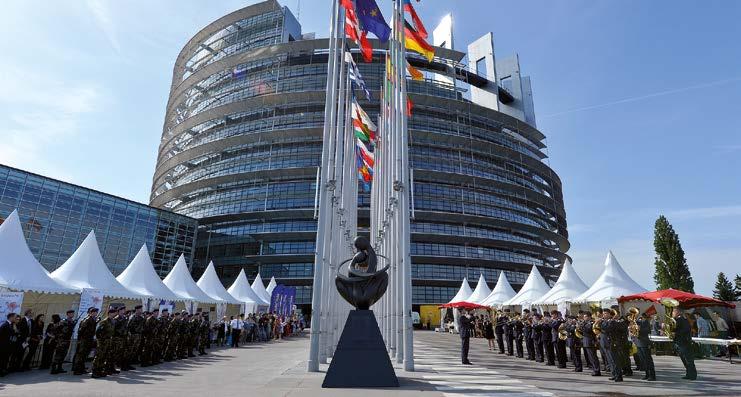THE EUROPEAN – SECURITY AND DEFENCE UNION
Satellite capabilities are key to enable high-tech government applications
Empowering governments to protect their nations with innovative satellite-based solutions by Nicole Robinson, Senior Vice President Global Government, SES Networks, Luxembourg
T
he drive for sophisticated communications applications in the defence and security space has significantly increased over the past few years. Five years ago, a data rate of 5 Mbps to support ISR platforms was more than sufficient. Now, these same platforms will seek up to 100 Mbps to deliver live streaming, full motion video to enhance situational awareness. The shift towards data-centric applications is prevalent throughout all areas of defence and security activities, including mission- critical tasks that are at sea, land, airborne, as well as crisis response and troops welfare.
Multi-orbit capabilities for government needs Given the growing appetite for bandwidth and services, we are harnessing our strengths as the world’s only multi-orbit operator, with the fleet of over 70 satellites in Medium Earth (MEO) and Geostationary (GEO) orbits. The services managed on the MEO network are more suited for latency-sensitive applications whereas the GEO HTS payloads could be used for applications that need both reach and bandwidth. To further meet the growing data demands, we have invested in the next generation MEO system O3b mPOWER. To be launched in 2021, this multi-terabit system will further boost network-centric operations via a “virtual fibre” network, serving the needs for cloud-based applications. O3b mPOWER will have multiple layers of active and inherent security and will feature over 4,000 beams per satellite, innovative ground infrastructure, software intelligence and automation, and will enable governments to autonomously manage beam capacity and location.
Advancing innovative approaches and technologies In addition to investing in more powerful and flexible satellite systems, we also offer governments innovative solutions in areas, such as commercially hosted government payloads. The European Commission and NASA are well versed in these programes, leveraging space and power on a commercial satellite to launch dedicated missions more rapidly than with a government-owned program. We also advance cutting-edge innovation through the synergy of R&D, industry and institutions, combatting the threats of the future. Through a program called QUARTZ (Quantum Cryptog-
62
raphy Telecommunication System), we will witness the power of combining the scientific communities’ research and industry expertise, within the ESA ARTES ScyLight programme. SESlead consortium is developing a satellite-based Quantum Key Distribution system and service architecture, that will result in a powerful tool for providing safe and intrusion-resistant data exchange. When the mission success is at a stake, the ability to bring enhanced communications rapidly is key. An innovative way for governments to guarantee cost-efficient access to secure satellite communications is to pool and share satellite communications systems. SES is leading a consortium within ESA’s GovSatCom Precursor Program, PACIS-1, to ensure governments can access secured networks at short notice. The European Commission has taken an important step in the direction of calling on the capabilities of the satellite communications industry, when it outlined an approach to securing its Space Strategy in the EU GovSatCom initiative. Together with the EDA, the Commission recognised that space and satellite communications are key elements of infrastructure in meeting the defence and security needs. The GovSatCom initiative will help reduce the fragmentation of demand and act as an anchor to guarantee access, coordinate requirements and ensure security.
Synergy of governments and private sector Innovations also spread towards the way governments are served today, including through forming public-private partnerships. One such powerful example is a 50/50 joint venture between the Government of Luxembourg and SES, called GovSat. It reveals the advantage of government involvement, which is serving its own strategies and NATO, as well as the ability to leverage private sector efficiencies. GovSat’s satellite GovSat-1 represents an international platform and is a true game changer: it provides for many countries access to highly secure capabilities exclusively designed for governments and institutions. Secure satellite-enabled connectivity solutions transform people’s day-to-day experience while on a critical mission, help raise morale and welfare, and more importantly save lives. Leveraging engagement of governments and the efficiency of a commercial organisation is certainly the way forward in order to further innovate and make the economics of secure communications systems increasingly more attractive and accessible.

















